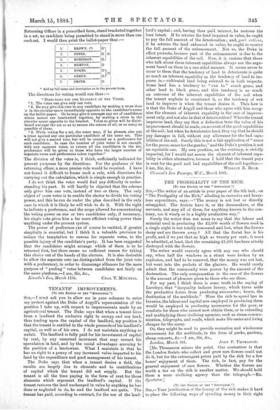PROPORTIONAL REPRESENTATION.
[To THE EDITOR OP THE "SPECTATOR.") Sia,—The question of Proportional Representation, as it is now called, is becoming a pressing one. May I describe a scheme, for which I can claim no great originality, but which is an attempt to work out in a practical form what seems to me the best plan of solving the difficulty P Perhaps the simplest method of explaining the plan would be to give its essential provisions as they would appear on the ballot-paper, and on the " Directions for the Guidance of the Voter," which the Ballot Act requires to be placarded at all polling stations. No plan of proportional representation can be applied fairly except where three or more Members are to be re- turned by the same constituency. In such case the rules for nomination would provide that any number of candidates not exceeding the number to be returned might, on notice to the
Returning Officer in a prescribed form, stand bracketed together in a set, no candidate being permitted to stand in more than one -such set. I would then print the ballot-paper thus :—
1: BROWN. (*) 0 0 0 0 0 0 0o
JONES.
ROBINSON.
MERTON.
NOICES.
GREEN.
SMITH.
• Add:ng full name and description as in the present form. 'The directions for voting would run thus :—
" DIRECTIONS FOR THE GUIDANCE OF THE VOTER.
"1. The voter can give only one vote.
"2. He may give this vote to any candidate by making a cross thus 'X in the circular space immediately opposite to the candidate's name on the ballot-paper. Or he may give it amongst any set of candidates whose names are bracketted together, by making a cross in the circular space opposite to the bracket. Votes so given will be distri- buted amongst the set so as to secure the return of all, or as many as possible of them. "3. While voting for a set, the voter may, if he pleases, also put -a cross against any one particular candidate of the same set. This will not give a second vote, but will be counted as a preference for -such candidate. In case the number of joint votes is not enough, with any separate votes, to return all the candidates in the set, preference will be given to those who have the larger number of -separate votes and preferences taken together."
"The division of the votes is, I think, sufficiently indicated for present purposes by the directions. For the guidance of the -returning officer, a more precise rule would be required. I have not found it difficult to frame such a rule, with directions for carrying out the calculation, which is simple enough in practice.
I do not think the voter would find any difficulty in under- standing his part. It will hardly be objected that the scheme -only gives him one vote, instead of two or three. The only 'object of more votes is to enable the elector to divide his voting power, and this he can do under the plan described in the only case in which it is likely he will wish to do it. With the right to indicate a preference, and the scope allowed for concentrating the voting power on one or two candidates only, if necessary, his single vote gives him a far more efficient voting power than -anything under the present system.
The power of preference can of course be omitted, if greater simplicity is essential, but I thihk it a valuable provision to 'reduce the temptation to canvas for separate votes, to the 'possible injury of the candidate's party. It has been suggested that the candidates might arrange which of them is to be returned first, but there seems no sufficient reason for taking this choice out of the hands of the electors. It is also desirable to allow the separate vote (as distinguished from the joint vote with a preference), in order to discourage alliances for the mere purpose of " pooling " votes between candidates not fairly on the same platform.—I am, Sir, &c.,



































 Previous page
Previous page